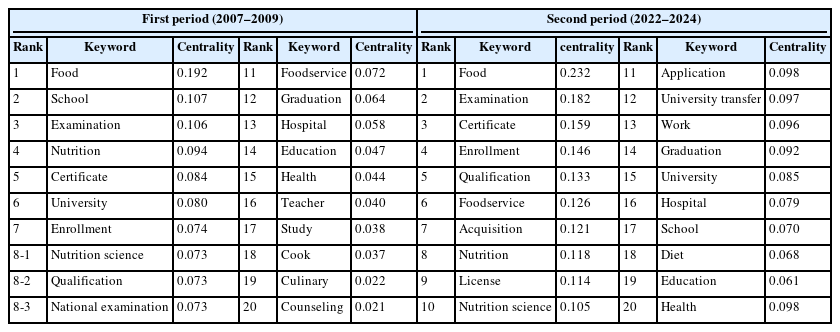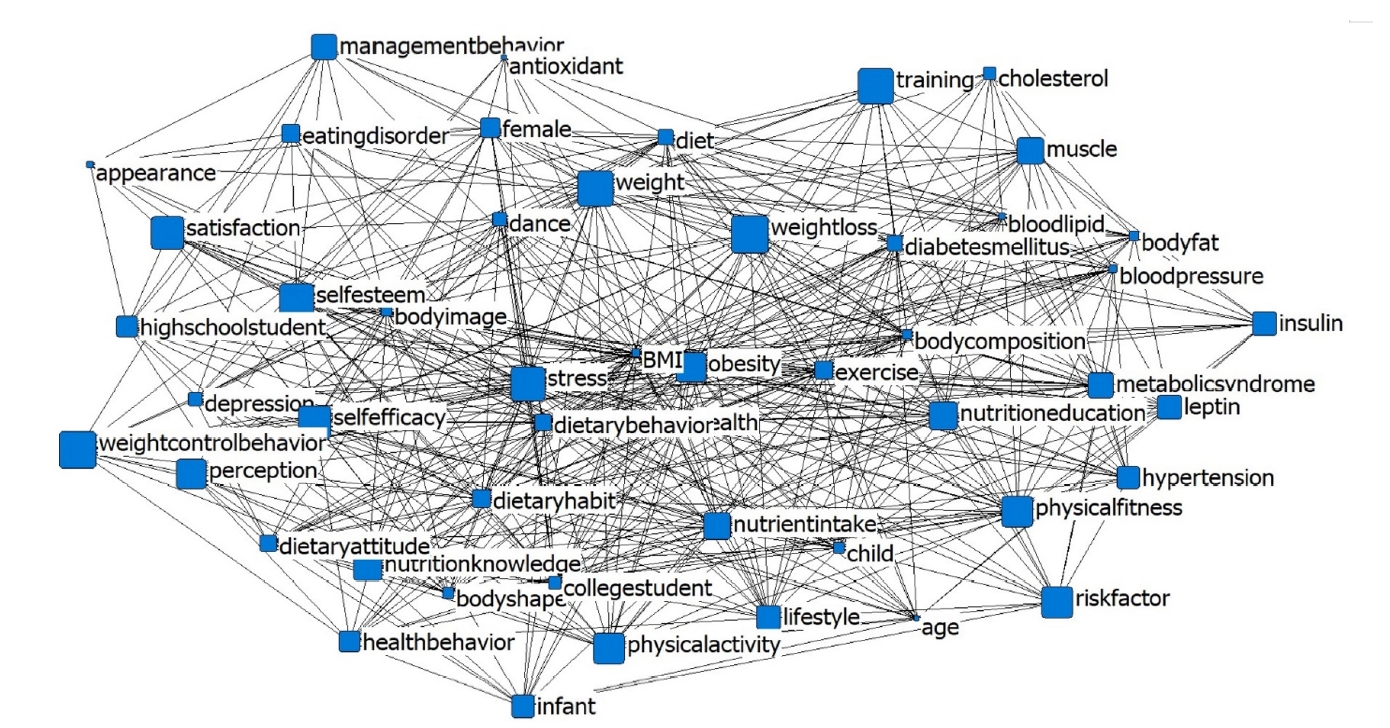- [English]
-
Safety education status and needs priorities of Korean military food service personnel using the Borich Needs Assessment and the Locus for Focus model: a cross-sectional study
-
Jeongeun Park, Eunsil Her
-
Korean J Community Nutr 2025;30(4):261-273. Published online August 29, 2025
-
DOI: https://doi.org/10.5720/kjcn.2025.00185
-
-
 Abstract Abstract
 PDF PDF
- Objectives
Since the enactment of the Serious Accidents Punishment Act in Korea in 2021, the importance of safety management in food service facilities has increased. This study was conducted to examine the status of safety education and to identify educational needs for safety accident prevention among army food service personnel.
Methods
This study included 157 food service personnel from Army units located in Gyeongsangnam-do. Participants were divided into two groups based on the daily number of meals served. Demographic characteristics, the status of safety education, and priority for safety accident prevention education were evaluated.
Results
A total of 97.5% of participants received safety education, with 60.8% attending at least monthly. “Lecture” (63.4%) was the most commonly used educational method. The preferred educational methods were “Lecture” (23.5%) and “Counselling” (23.5%), showing significant group differences (P < 0.001). A total of 79.6% of participants reported applying the educational content in their performance. The mean importance score for safety accident prevention (4.78) was higher than the performance score (4.44), with significant differences between the two groups observed in the importance scores (P < 0.05). “Slip & burn” had the highest importance score, while “Electric shock and fire” had the highest performance score. The educational needs analysis revealed that the highest priority item for the < 100 meals group was “When moving heavy items, an assistive device or assistance from colleagues should be utilized”, while for the ≥ 100 meals group, it was “When using a vegetable cutter or grinder, use an exclusive stick.”
Conclusion
This study can serve as a foundational database for developing customized safety education programs tailored to Korean army food service personnel.
- [English]
-
Shifting social perceptions of dietitians in Korea after the legislation of nutrition teachers: a keyword network analysis of unstructured data
-
Yunkyoung Oh, Eunsil Her
-
Korean J Community Nutr 2025;30(3):214-223. Published online June 30, 2025
-
DOI: https://doi.org/10.5720/kjcn.2025.00045
-
-
 Abstract Abstract
 PDF PDF
- Objectives
In Korea, dietitian licenses began to be issued in 1964, and they have been working to prevent diseases and promote people’s health in various fields according to the times. This study was conducted to compare differences in social perception of dietitian over time by collecting online unstructured data and analyzing the frequency and network structure of nutritionist-related keywords after the deployment of nutrition teachers began.
Methods
Using ‘dietitian’ as a keyword, we collected data from NAVER’s web, blogs, and news provided by Textom (2024, The IMC) and refined the data. We investigated the frequency ranking of keywords related to dietitians for each period, revealed the network structure using UCINET6 (Freeman) and Netdraw, and clustered similar concepts among keywords through CONCOR (CONvergence of iterated CORrelations) analysis to cluster-related concepts.
Results
Frequency analysis revealed that during the first period, keywords such as “School” and “Education” reflecting the institutionalization of nutrition teachers, were highly ranked. However, by the second period, these terms had dropped out of the top 10. Meanwhile, keywords related to healthcare, such as “Hospital”, consistently remained among the most prominent. In the second period, the rankings of the “License” and “University transfer” keywords increased significantly. Centrality analysis showed stronger connectivity between dietitians and keywords such as “Food”, “School”, “Examination”, and “Nutrition” in the second period compared to the first. CONCOR analysis further demonstrated that the “Major education” cluster of the first period was differentiated into the “Major education and qualification” and “professional competency certification process” clusters of the second period. In addition, the “Health and welfare” cluster of the first period was divided into the “Health and welfare regional service” clusters of the second period.
Conclusion
The results of this study will be used as basic data for identifying social perception and trends in the dietitian profession, further providing a scope for their improvement.
- [English]
-
Research trends relating to body weight control: a systematic review and keyword network analysis of Korea Citation Index Journals (2004–2023)
-
Yunkyoung Oh, Eunsil Her
-
Korean J Community Nutr 2024;29(6):445-454. Published online December 31, 2024
-
DOI: https://doi.org/10.5720/kjcn.2024.00269
-
-
 Abstract Abstract
 PDF PDF
- Objectives
Obesity rates are rapidly rising in Korea. Weight control is highly involved in obesity treatment. This study aimed to explore research trends related to weight control through keyword network analysis. By focusing on journals indexed in the Korea Citation Index (KCI), this study highlights trends specific to Korea, offering insights that reflect the country’s unique cultural and policy contexts in weight control research.
Methods
This study collected keywords from weight control-related papers published in the KCI journal over the past 20 years. Keywords were cleaned through Textom (2024), and the relationships between key research issue frequency analysis, structural characteristics, and keywords were identified using Textom, UCINET6, and NetDraw.
Results
Over the past 20 years, 40 to 50 studies related to weight control have been conducted each year. The Korean Journal of Community Nutrition had the largest number of published articles. Keyword frequency analysis showed that ‘obesity’ had the highest frequency. And the analysis of degree centrality and betweenness centrality, the keyword ‘obesity’ ranked the highest. CONCOR analysis identified four clusters: preventive health care, health management, physical health, and personal development.
Conclusion
The results of this study showed that weight control research reflecting the characteristics of the times has been steadily progressing in relation to the rapidly increasing obesity in Korea, and when developing policies or setting research directions related to weight loss in the future, research should be conducted in a prospective manner by subdividing it according to groups and interests.
- [English]
-
Metabolic Syndrome Risk by Intake Ratio and Intake Pattern of Proteins in Middle-aged Men Based on the 2012-2013 Korean National Health and Nutrition Examination Survey Data
-
Minkyoung Jang, Eunsil Her, Kyunghea Lee
-
Korean J Community Nutr 2016;21(4):366-377. Published online August 31, 2016
-
DOI: https://doi.org/10.5720/kjcn.2016.21.4.366
-
-
 Abstract Abstract
 PDF PDF
- OBJECTIVES
The purpose of the study was to compare intake of energy nutrients, physical characteristics, and the prevalence of metabolic syndrome according to protein intake group.
METHODS
Subjects were 827 men aged 40-65 years. The results presented were based on data from the 2012-2013 National Health and Nutrition Examination Survey and analyzed using SPSS. The odds ratio (OR) of metabolic syndrome was assessed according to the protein intake group and intake pattern of protein-rich foods.
RESULTS
The mean of protein intake was 73.96 ± 0.71 g. According to level of protein intake, four groups (deficient, normal, excess 1, excess 2) were created and their percentages were 8.3%, 39.6%, 37.1%, and 15.0% respectively. The mean of daily energy intake was 2,312.33 ± 24.08 kcal. It was higher in excess group 2 than in the deficiency group (p < 0.001). Moreover, the intake of all energy nutrients increased significantly with protein intake group (p < 0.001). The main contribution to daily protein included mixed grains (10.96 ± 0.32 g), milled rice (7.14 ± 0.30 g), chicken (3.50 ± 0.21 g), and grilled pork belly (3.04 ± 0.16 g). With regard to physical characteristics, and blood pressure and blood test results, only body mass index increased significantly according to protein intake groups (p < 0.05). The prevalence of metabolic syndrome in subjects was 38.5%, and there was no significant correlation with protein intake group. The OR of metabolic syndrome increased with protein intake, and was higher 4.452 times in excess group 2 than in the normal group (p < 0.05). Conversely, the OR of metabolic syndrome according to the frequency of protein-rich food intake did not show a significant correlation.
CONCLUSIONS
The results of this study can be used as significant supporting data to establish guidelines for protein intake in middle-aged men.
-
Citations
Citations to this article as recorded by  - Evaluation of diet quality according to the eating-out patterns of preschoolers and school-aged children in South Korea: based on data from the 2016–2018 Korea National Health and Nutrition Examination Survey
Yu-na Ju, Youngmi Lee, Kyunghee Song, Yujin Lee
Journal of Nutrition and Health.2021; 54(2): 165. CrossRef - Dietary Safety Management Awareness and Competency for Healthcare among Adults in Daegu and Gyeongbuk Areas
Yunhwa Kim
Korean Journal of Community Nutrition.2020; 25(2): 112. CrossRef - Metabolic Syndrome Risk by Dietary Fat Energy Ratio in Middle-aged Men - Using the 2012~2013 Korean National Health and Nutrition Examination Survey Data -
Eun-Sil Her
The Korean Journal of Food And Nutrition.2016; 29(6): 1030. CrossRef
-
918
View
-
0
Download
-
3
Crossref
- [English]
-
The relationship between Physical Growth and Major Sources of Serum Vitamin D among Hospitalized Children of Changwon City
-
Haeyoung Kang, Eunsil Her, Kyung Hea Lee
-
Korean J Community Nutr 2015;20(3):197-207. Published online June 30, 2015
-
DOI: https://doi.org/10.5720/kjcn.2015.20.3.197
-
-
 Abstract Abstract
 PDF PDF
- OBJECTIVES
This study was conducted to investigate the effects of the sources of vitamin D (duration of exposure to sunlight, intake of major food sources for vitamin D or vitamin D supplements) on the serum 25-(OH) D3 levels, and the physical growth of a child.
METHODS
Subjects were 296 children aged 1 to 5 years who visited S hospital located in Changwon City. Survey data collection was carried out by direct interview method, and the biochemical data were collected using hospital records.
RESULTS
The study subjects were divided into three groups according to their levels of serum 25-(OH) D3 (deficient, relatively insufficient, sufficient) and their percentage were 48.3%, 44.3% and 7.4% respectively. The average concentration of serum 25-(OH) D3 was 20.41 +/- 6.55 ng/mL, which was relatively insufficient. The average duration of exposure to sunlight was 58.86 +/- 49.18 minutes/day. A total score of vitamin D major food sources was 46.71 points (full marks 153), and the most frequently consumed food items were milk, eggs, and cheese. Thirty-four percent of the subjects took vitamin D supplements and their dose were 11.96 microg/day. Three vitamin D sources in sufficient group were higher than deficient or relatively insufficient group significantly. Intake of vitamin D supplements showed positive relation (+) and high explanation power (R2= 0.288) on serum 25-(OH) D3 concentration, but intake of vitamin D major food sources (+) and the duration of exposure to sunlight (+) had a low explanation power (R2= 0.068). The relations between serum 25-(OH) D3 concentration and physical growth (height and weight) were shown as negative (??, and their explanation powers were low as 7.3% and 5.9% respectively.
CONCLUSIONS
This study results can be useful when discussing the intake standard of vitamin D and the effective intake method for children. In addition, it will be helpful to build the children's nutrition policy and to plan the nutrition education program to improve the vitamin D status in children.
|
















